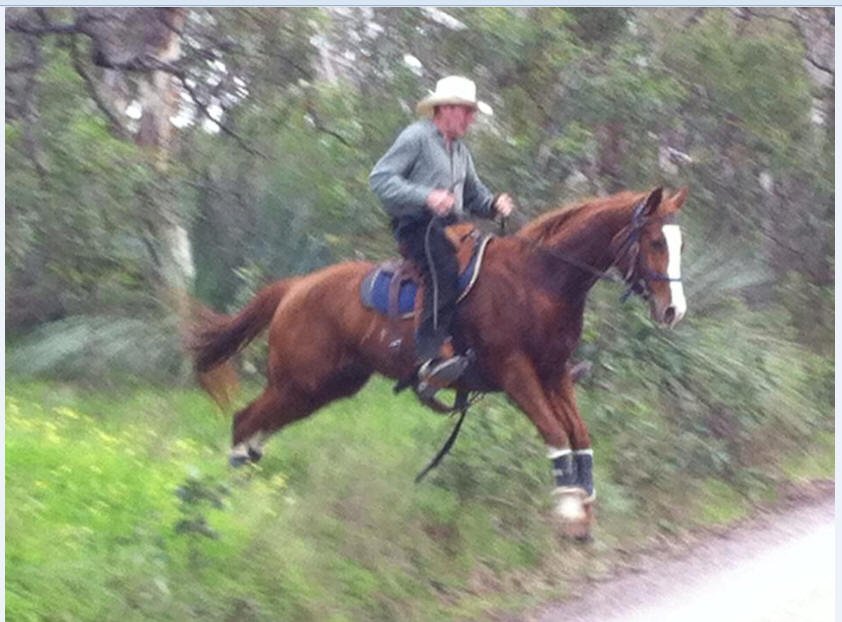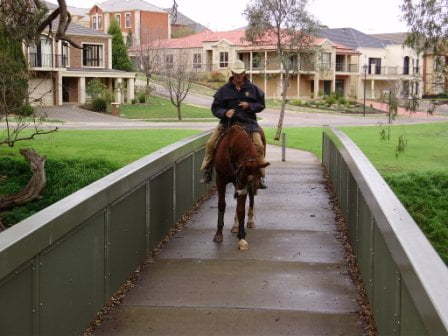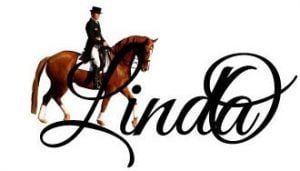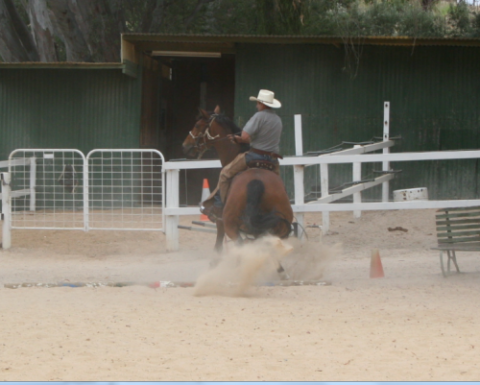“A bold rider makes a bold horse and a nervous rider makes a nervous horse”
Horses with Ulcers shy way more than if they haven’t got such
Without doubt, more riders fall off horses due to the horse shying than from horses bucking. Shying is a description for the horse unexpectedly, suddenly and violently jumping one way or the other and is caused by the horse exhibiting fear of something that it has seen come into it’s surroundings. This fear of whatever, and the resultant leap to escape is caused by the natural inbred flight response, which forms part of the makeup of the horse and stems from their evolution as a hunted animal. Their eyes are set on the size of their heads in order to have a field of vision measuring almost 360 degrees and they are ever vigilant.
Some horses shy only because of this natural instinct and yet I have met others that purposely manufacture things to shy at. Others do it to get out of flat work. I have met more than one budding ‘Dressage Queen’ who has been chopping down the odd spooky tree.
Horses shy far less in company than when ridden alone. The lead horse will shy far more than the rest of the following horses and normally they don’t at all. Reason? That the lead horse has to be the total leader. It’s head is one meter in front of the rider’s and therefore, in it’s mind, it is doing all the leading. The trick is to convert the horse’s thinking that you are the one doing the leading and it is only the vehicle. To have it be totally confident in your leadership. It doesn’t want to lead, it wants you to.
Certain types of rider’s can suppress or enhance shying, depending upon their attitude, personality and riding style. I have a saying, which I think is one of the truisms of riding horses.
HORSE STARTING
The quality of the Horse starting is crucial. Those who do not ‘Bush Bash’ and ‘Road/Traffic Train’ expose the Horse to a less confidence career. All of mine have gained much boldness from this.

The effect that a nervous rider has on a horse is amazing. It happens immediately and has a lasting effect; increasing in intensity the longer that nervous rider is aboard. It is so evident to me, that I could send a lone nervous rider around the 5 kilometer block on a horse today and tomorrow I could ride the same horse, around the same course and write down the location and describe the events that happened the day before. It is therefore evident that failure by the rider to make horses confront their fears causes a compounding of this negative reaction. Put simply, causing horses to shy more. ( I have done it)
So you can see, the rider not only has a responsibility to support a horse to overcome its inherent fears, but also to insist that the horse does listen, thereby making it a safer ride. So what causes the differing levels of boldness in horses?
I find that breeding does have a marginal effect, but not a huge one. There is no doubting that certain breeds of horses have a higher propensity of being “lookers”, than others. I don’t ride many, but I can always quickly identify a potential Eventer, during the first few rides of the breaking in. However, I have learnt from riding thousands of them, that the overwhelming reasons are:
- A lack of boldness and aggression in riders’
- A lack of knowledge of how to ride such horses, largely caused by inadequacies in Educational systems.
I ride shyers for a living, almost every day of my life, including today. The one I rode today, was caused by the owner, having her first ride on her newly broken in horse and that young horse feeling the vibes transferred by the owner, who, was as nervous as hell. Understandable true, but the reality of life is that the vibes of the rider causes a high degree of shying. Hence my sayings:
- ” bold rider makes a bold horse” and
- “A nervous rider makes a nervous horse”
I ride every horse that I start out in Suburban traffic. An 80k main road. Regardless of the breed, they rarely shy. It never matters what breed they are and so this is what has always made me believe that shying is all about the rider. I often ride horses in this traffic on their 4th or 5th ride in their lives but recently, I rode one out on it’s second only ride. No shying.

The last one I met was was trucked 1,000k to me as it was fearful of everything. He was fixed in one ride.
Shying is all about the flight response kicking into gear and that instinct being directly fostered and fed by the attitude of the rider, versus it being cancelled out by the attitude, confidence and ability of the rider. So there is a direct relationship, up and down the scale.
If one presents a horse to a horse float and the horse fails to load, a percentage of handlers will then turn that horse away from the float and represent. This gives the horse “Reward and Relief” for not floating and immediately signals to the horse that it is now training the owner.
If one approaches a cross-country jump and the horse runs out to the right, a percentage of riders will then circle to the right and represent to the jump. They have immediately given the horse “Reward and Relief” for running out and the horse immediately knows that if it runs out again, it will be supported in it’s endeavors by the rider who actually co-operates and assists in the run out process by continuing their circle on the right rein rather than making the horse go back to the left, the rein that it failed to answer in the first place. The horse therefore is training the rider.
As an extension to this and many other arguments similar, if there is a goat chained to a fence that you are going to ride by, and that goat is on your left, the horse will shy to the right. When the horse veers, bends or shies to the right, the rider has very few options. Pull on the left rein and keep the horse looking at the goat until you manage to get past it and go on, pull on the right rein and do a one rein stop, spin, circle, take your pick or to counter bend and leg yield the horse towards the goat in an effort to stop it from ending up in the middle of the road.
LEG YIELDING
You can rule out leg yielding for almost all riders as few horses will be so trained off the leg as to over come the fear and desire to flee. (Other than the Western Show world of horses) If you pull on the right rein, you are giving the horse precisely what it wants. You are showing the horse “the out” and inviting it to take the escape route. If you are supposed to be the leader then, what is the horse to think? “If Mum points me away from the goat, Mum must be bloody terrified of goats and if Mum is, the horse surely must be more frightened. You are pointing it’s nose to the direction of escape and when you do that, that is exactly what the horse will do, escape, run, whatever. Even if you complete the one rein stop to the right and win a partial battle, you have not trained the horse. You have nullified it’s run, but you have not progressed in it’s training. I would however, be quite proud of you if you did do a ‘One Rein Stop” though. However, I ride them all the opposite to this.
ADVANCE AND RETREAT
The moment the horse signals a rise in it’s suspicion and fear level, I commence on the left rein. I never want to take the horse nearer to the goat or up to the goat; all I want is for it to go past the goat without shying to the right. I use the left rein in a direct percentage of controlling the angle of the horse, in order to nullify any chance of run to the right. If I have to end up side passing by the goat, I will, but I will not be pulling on the right rein. I may even turn the side pass into a leg yielding training opportunity, as I am a complete smart ass. If I have pulled on two reins I would be telling the horse that I am frightened because I have done what all nervous riders’ do.
As well as this rein control, I use what ever level of energy that is required to keep the horse going forward and then as I feel the fear level subsiding and as the goat passes by, I go progressively more right rein and straighten up, continuing on in an un-interrupted trail ride with the minimum of fuss and on a loose rein. Pleasure horses must be ridden on a pleasure rein. Holding a contact on pleasure horses is without doubt, the second biggest cause of tension in horses on trail rides to rider’s vibes. It is the cause of the dancing, prancing horses or the world, the piaffe, passage, (rider pioofed) and rearing. For a horse to be relaxed on a pleasure ride it must be able to lower its neck and a horse cannot lower its neck if it is on a contact.
So, to fix a shyer, one must win each and every battle and as you do so, each new and frightening item is cancelled out. Cancel them all out and you have the perfect trail horse.
One major mistake that I see people make with ‘shies’ is to make a bigger issue of the frightening . They try to force the horse to go up to it, sniff it, touch it. This is buying on an argument that most cannot win and is simply not fair on the horse. It is also against correct training technique imho and I know a lot of Trainers’ agree with me. It is far better to go past an object within a reasonable distance than trying to approach it and lose a battle. Over time, the horse will feel comfortable in going closer to each of these frightening objects, without a major fight.
Speed has a direct bearing on the amount and intensity that a horse may want to shy. It is twice as difficult to rider a shying horse at the trot and three times as hard at the canter. The reason? Everything is coming at the horse faster and it has less time to assess each object for it’s danger.
The success of cancelling out each shying category is found in the rider winning every time, no matter how frightened the horse may be. If this occurs, there is a benefit to the horse in terms of cancelling a large percentage of fear in that particular item on the long list of things that the horse might like to shy at. Cancel them all out and you do not have a shyer. Success breed’s success, confusion or partial failure equals an increased propensity to shy.
REIN CONTROL
If you make a horse look into the opening of a bridge and no matter how hard the horse tries to evade that bridge ,you negate the horse’s attempts at turning it’s head away, whilst generating the horse forward to the point where the horse must go forward, then it just has to go over the bridge. End of story.
Now the rein control for this exercise is definitely two open reins. Your forearms are still in proper dressage position, the rein hands travel past the hip, but your hands should be set a little wider. So, as fast as the horse tries to evade left and right with its head, the rein hand negates the opportunity and cancels out the attempt. Only one rein is used at a time with the other loopy. Never pressure on both side of the mouth. No different to loading onto a float. If the front handler simply does not allow the horse to ever look around the side of the float and the rear handler, say the whip person can generate the horse to go somewhere; the horse must go in the float.
Evading the entrance of a footbridge is however, a continual series of shies, together forming the evasion. Rein control stops evasion and whip, spur etc, provides the forwardness to complete the rider’s wishes. Sophistication should be added however, rewarding the horse for slight forward movements, allowing the horse to put it’s head down to sniff, etc. Incidentally, this will almost always happen, just before the horse proceeds and is a sure sign that the horse has already decided to cross. Providing you don’t make any mistakes at the last moment.
When a horse is facing directly at the bridge opening, you must be giving with both reins. No contact on the mouth at all. This is highly important and I keep saying it in various ways. I can’t think of a reason why contact would be made to the mouth of a horse during a battle over evasion.
How do we ride a shying horse? Why do so many people fall off them? I know I have the luxury of lots of practice, but I believe it is the riding technique that is the cause. The technique that is not taught at Riding Schools.
I mentioned earlier that you must temporarily forget your dressage training, the moment you run into trouble out on the trail or anywhere else for that matter. Dare I say it, even on the Dressage Arena. So to ride a shying horse, you must ride like the rider of a “Cutting Horse”. After all, the cutting horse has to be the most violent shying horse in the world and the Cutting Competitors’ have to be the best riders of shying horses.
When a horse shies to the right, you are forced off the left side of the horse by the opposite force. The major reason good riders’ don’t fall off the horse that shies is their ability to read the event before it happens. You are then prepared. The other reason is reaction time. The more you ride them the better you get at it. Finally, the way you use your position and how you hold your legs has a major bearing on your stability.
Forget about everything you have ever been taught regarding dressage position. That will cause your dislodgement. If a horse shies to the right, here is what you must do:
- twist your hips to the right slightly
- lock up your left hip, knee and ankle joints.
- Basically have a straight left leg, from stirrup to hip.
- Throw your left leg forward of the girth.
Now, as the force that is throwing you off the left side of the horse commences, you will have locked against it and become part of the horse, which, as it travels to the right, catapults you to the right with it. The left stirrup iron becomes the slingshot and you the missile. Only thing is that you are traveling in the same direction and at the same speed as the horse and arrive simultaneously at the same location.
As I said, the cutting horse is the best continuous shying horse of all and the cutting rider is simply reading the impending change in direction, locking the appropriate leg and being catapulted with the horse. It matters not what the other leg is doing at all.
SHYING ON AN ARENA
Often horses will use shying as a way to get out of work on the Dressage arena. They will pick certain spots or objects and basically drive the rider mad as hell.
To fix this particular horse, you must have them basically more respectful of your spur or leg than the so called frightening object. We get horses like that regularly and fix every one of them. You must teach them the lateral movements so good that your leg aids simply ‘outgun’ the desire to run against them.
So I do hope that you have gained some tips through this article and I wish you all the very best of luck in the future.
RELEVANT ARCHIVAL NEWS ON THIS SUBJECT
27th November, 2004
Well, my 3 year old young Warmblood, the first foal of my wife’s Stallion, goes home today. Yesterday morning, I led my wife around the block on the main road during the morning rush hour traffic and I was very proud of him. He hadn’t been on half of the trip and it included a roundabout and heavy truck movement with some of the main road only allowing a distance of 2 metres from the cars.
I want to mention this as I found it a very interesting observation. You know my saying, “A bold rider makes a bold horse” and that is exactly what has happened her because this young one was not the worlds bravest, but during this ride I had an interesting first hand look at the proof of the statement. I wanted to go second, just to give the young horse’s brain a rest from the pressures of having to confront everything on his own during the last week. I thought that if he could follow, on a loopy rein, that it would mellow him further and be the icing on the cake but I didn’t figure on what happened. Mrs. HP’s was riding the rising 20 year old ‘Gazette’, who apart from being a total A hole, will emit the nervous vibes on a ride too. I found that the young horse was actually worse walking behind Gazette than he had been the morning before, on his own. I put up with that for 1k and then said to my wife that I would like to lead instead. Immediately and progressively, he go less nervous to the level of the day before and then improving on that for the last bit of the ride. So what did we learn from that.
That a horse will be supported more by a ‘Bold Rider’, than the company of other horses.

Listen to Your Horses

